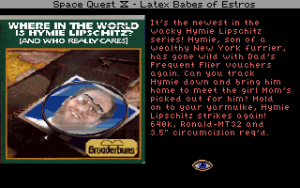

The limited insight we do have into the game’s production is based on two sources: a single promotional interview for the game that Choi gave with the adventure game enthusiast website Just Adventure, 2 as well as a personal statement he included in the game’s manual. Kyle Choi has maintained a low profile since the game’s release, and he could not be reached for this article.

Little is known about the development of Comer. It’s also an object that begs for additional context that can be hard to come by, which emphasizes the need to turn to the informal resources compiled by the video game fan community. For an outlier game like Comer that lacks a canonical record, a physical copy can speak volumes about its production, arguably more than it would for a typical retail game. Trying to make historical sense of Comer forces us to rethink how we approach the material history of games like this on the fringes of the commercial industry. This game took a long, weird journey, and yet it left very little trace of its existence along the way. Here and now, another ‘Bang!’ is taking shape. Usually in a drastic ‘Bang!’, one period ended, lives were wiped out, new cycle started. In an ancient oriental script of prophecy, life was referred to as ‘The Game of Zao Hua.’ In modern terms, it might be ‘The Game of Creation and Evolution of Life.’ The study of prehistoric earth reveals that there were periods of lifeforms such as that of dinosaurs and that of mammals. Be a COMER and experience the story, 3D graphics, stereo sound with a quality of no compromise. The front of the box reads: “COMER is an interactive adventure into the surreal world of natural and architectural wonders. The box for Kyle Choi’s Comer (Shine Studio, 1998).

But its most interesting feature is a warning label on the top of the box, advising that the game was only intended to be sold in “Hong Kong, Mainland China, Taiwan, Singapore.” This was even more surprising because this copy of the game shipped to me from Athens, Greece.
Hg101 little big adventure 2 box art manual#
The manual was printed at a low resolution in the default Times New Roman font used in office software in the 1990s, as if it came directly out of an old version of Microsoft Word, and its text-heavy dual-language packaging design, presented in Chinese and English on opposite sides of the box, doesn’t adhere to any standard design practices of the video game industry. It looks like it was manufactured professionally, but its shape and size are slightly too squat for a so-called big-box computer game from this era (fig. Just examining the box, it seems to exist in an undefined space between formal and informal game publishing that defies easy categorization. Over the summer, an internet user going by the name Kite Line sent me a copy of Comer, which they had ordered from eBay.

But the story of Comer gets even more complicated when we look at a rare physical copy of the game itself. 1 Comer was produced entirely by one person working alone, without support from a publisher, distributor, or any other industry group, which means there is almost no official documentation for this game or its development. These are questions we need to confront when dealing with Comer, a surreal adventure game from Hong Kong that was self-published by its designer, Kyle Choi, in 1998. How can we fit something into the bigger history of video games when it can’t be interpreted in the same way, when a physical copy of the game raises more questions about its publishing history than it answers, and when its mode of production is so unconventional that there’s hardly any formal record that the game exists at all? If this is how we make historical sense of games and their developers, how do we deal with a game that was produced outside the traditional practices of the industry? I’m not just referring to an independent game, or a game with an unusual development story, but a video game that was designed completely outside the structure of the game industry and does not conform to its standards. These are the materials that can be readily collected by museums, libraries, and archives, and those materials form the canonical record we rely on to understand the history of the medium. When a video game is produced, it leaves behind materials that make the game easier to account for, whether that’s ephemera, like advertisements, trailers, and promotional interviews, or simply a copy of the game that we can point to. The video game industry follows its own set of norms for publishing and marketing.


 0 kommentar(er)
0 kommentar(er)
